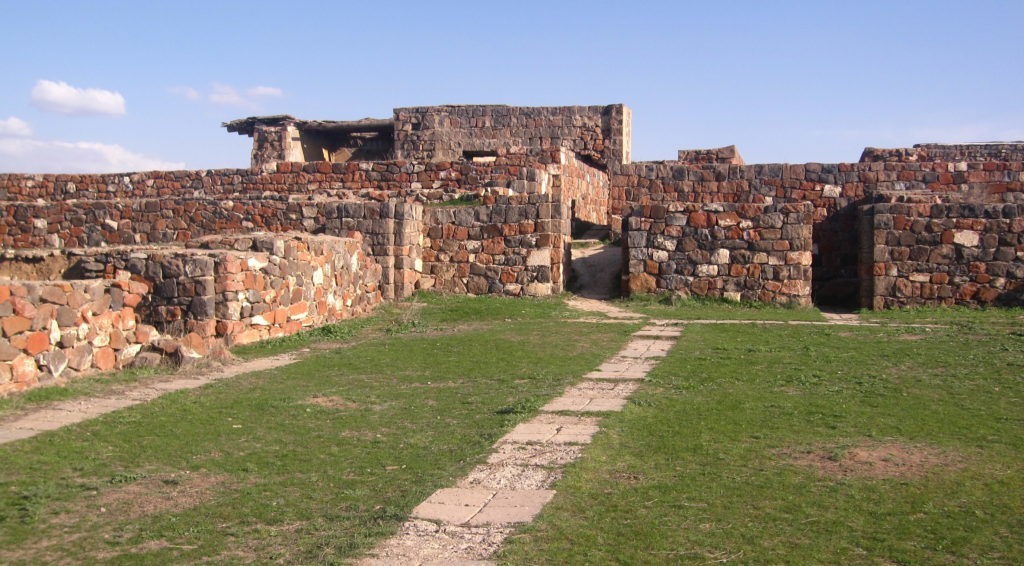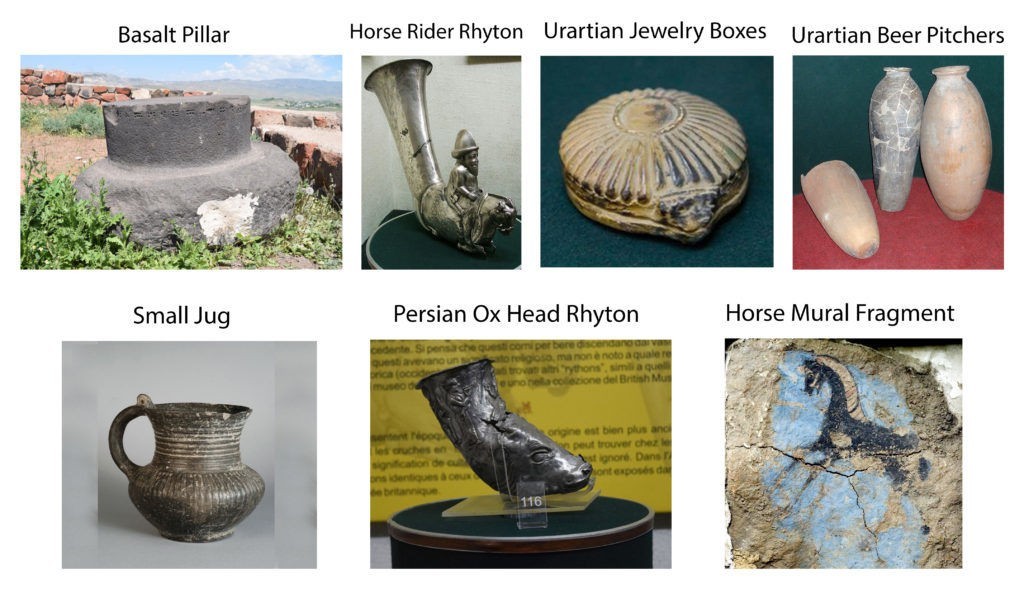Erebuni Fortress is also known as Arin Berd. It is an Urartian fortified settlement which is located in the outer parts of Yerevan, Armenia. The fortress is 1,017 meters above sea level. Originally there were several fortresses built along the northern Urartian border. Erebuni Fortress was one of the most important political, economic and cultural centers of the kingdom. The name of the capital Yerevan derived from the word Erebuni.
The Urartian Kingdom was an ancient kingdom situated along the River Aras. Between 785 and 753 BC, This kingdom was ruled by a king named Argisht I. He expanded his kingdom’s borders through many conquests were made. Similar to other settlements of the Urartian Kingdom Erebuni fortress had a clear-cut layout. A town was built at the foot of the hill and the citadel was constructed on top of the hill. The former was triangular in shape.
Etymology
The Meaning of the word Erebuni varies. According to the inscription found by researchers at Karmir Blur, people used the verb Erebu-ni as “to seize or steal”. Scholars believe that the word, as an unchanging direct object, may also mean “to take” or “to capture”. Hence it becomes clear that at the time of its founding ‘’Erebuni’’ meant “capture”, “conquest”, or “victory.
The historian Amjad Jaimoukha gives an alternative etymology. According to him ‘’Buni’’ comes from the Nakh root which came from the word bun and means shelter or cabin. However, the root simply means lair or shelter. Generally “bun” has Indo-European roots. According to the European roots, the word ”Buyn” means “birds nest” or “lair”.
History of Erebuni Fortress
First Stage
Erebuni was founded by Urartian King Argishti I in 782 BC. Armenians built Erebuni on top of a hill called Arin Berd. They did the construction of the fortress in various stages. The fortress served as a military stronghold to protect the kingdom’s northern borders. At first, this royal capital was a great administrative and religious center. Argishti began the construction of Erebuni after conquering the territories north of Yerevan. During these campaigns, he captured many people and ordered them to help build his town.
An archaeological expedition led by Konstantine Hovhannisyan discovered a record at Arin Berd referring to the city’s founding. This record was carved during Argishti’s reign and found in the autumn of 1950. The researchers also found two other identical records at the stronghold of Erebuni. The record says:
By the greatness of the God Khaldi, Argishti, son of Menua, built this mighty stronghold and proclaimed it Erebuni for the glory of Biainili (Urartu) and to instill fear among the king’s enemies.
In the record, Argishti said that the land was a desert and he did huge works in order to finish constructions.
Argishti left a similar record at the Urartian capital of Tushpa. Currently, people call it Van. In these records, Argishti told that he brought 6,600 prisoners of war from Khate and Tsupani to populate his new city.
Second Stage
Like other Urartian cities of the time, Erebuni Fortress was built on a triangular plan on top of a hill. It had 10-to-12-metre high ramparts. Behind them, the builders separated the constructions by central and inner walls. For building the walls people used a variety of materials, including basalt, tuff, wood, and adobe.
Argishti built a huge palace here. During the excavations made in this area, the researchers uncovered other beautiful buildings included a royal assembly hall, a temple dedicated to Khaldi, a citadel, living quarters, dormitories and storerooms. The inner walls presented religious and secular scenes. People completely decorated them with murals and other wall paintings.
During their military campaigns, the following Urartian kings made Erebuni their place of residence against northern invaders. The Urartian kings continued to build up the fortress defenses. Kings Sarduri II and Rusa I also used Erebuni as a staging site for new campaigns against the north. The state was under constant foreign invasion and in the early sixth century the Urartian state falls down.
Shortly afterward, this area began ruled by Achaemenian Empire. Erebuni Fortress had a strategic position. It became an important center of the satrapy of Armenia.
Though many foreign powers invaded here, people never completely abandoned the city. People of the country continually inhabited here the following centuries and gradually it becomes the city of Yerevan.
Armenians celebrated Erebuni’s close proximity to Yerevan in a wonderful festival held in September 1968. During the celebration, Armenian People commemorated Erebuni’s 2,750 th birthday.
Architecture
Erebuni Fortress was atop of Arin Berd. The main entrance to the fortress was located at the southeastern side of the hill. The door led to the central yard of the citadel.
Ceremonies held by the personal guards of Argishti I. The fortress had a strategic position. In the southwest part of the yard was a temple of the god Khaldi. This temple had a large long plan with a staircase that led to the roof of a ziggurat type tower and a side room on the lower floor.
On the left side of the wall, there was an altar for sacrifices. Armenians decorated the walls in this part with colorful frescoes and represent human figures, gods, geometric and floral designs.
One of the scenes represents god Khaldi standing on a lion with a warder in his left hand and a horned crown upon his head. People drew Khalid like that. The proof of it is the representations of finding at other sites.
The floor of the temple was completely different from the rest of the complex. The floor was made of wood floors and composed of small planks. They made the other rooms of clay-coated adobe floors that were faced with stone slabs.
Erebuni Plans
- Southern porch
- Primary entranceway
- Primary bailey
- apadana in place of Haldi temple
- Courtyard
- Susi temple
- Additional yard & storages
- Appearance palace
- Small fire worshippers temple
Excavations
First Stage
Initial excavations began during the 19th century however researchers did systematic studies at Erebuni in 1952. The sponsors of the excavations were the Armenian Academy of Sciences’ Institute of Archaeology and Ethnography and the Pushkin Museum’s Board for the Preservation and Restoration of Architectural Monuments. Konstantine Hovhannisyan and Boris Piotrovsky led the excavations and served as an adviser.
At the first stage of the studies (1950–1968), they found a royal assembly hall, temples and over a hundred rooms, as well as numerous Urartian artifacts, such as pottery, earthenware, belt-buckles, bracelets, beads, drinking vessels, helmets, arrows and silver coins.
The team found the fragments of frescos around the area. People decorated them with important religious themes, including “processions of gods, sacred animals, and trees of life”, as well as scenes of everyday life; hunting, cattle breeding, and agriculture.
Soon they found storage areas for grain, oil, and wine. On the doors of the storage areas, there were inscriptions that tell the people who built the storage area and the quantity of the objects placed in them. One of the inscriptions says:
By the greatness of god Chaldis, Sarduri, son of Argistis, built this house, and he also created these granaries. In one of them, there were 12,600 Kapis, another one had 11,500 Kapis; entirely 24,100 Kapis. Sarduri, son of Argistis, mighty king, king of the country Bianinili, ruler of the town of Tushpah.
Second Stage
The researchers found big and small jars. The enormous ceramic jars stored the wine and oil. These containers had markings upon them. Smaller ones have been used in brewing beer. People made the beer from barley. People used the other huge vessels to store foods and wine.
Small circular markings mentioned the amount that could be preserved inside. The large vessels were buried half-way into the soil. They kept the contents cool.
The researchers found abundant of inscriptions around the complex. They displayed some of the records in the museum, while the others are on the walls.
In 1968 Armenians established ‘’Erebuni Museum of History’’. The opening of the museum coincided with the 2750th anniversary of Yerevan. In the museum, you can see the items found during the excavations at Arin Berd and Karmir Blur. The items tell the history of the site.
Artifacts of Erebuni Fortress
Basalt Pillar
An ancient basalt pillar is in the southeastern part of the Erebuni Fortress. It is located on the outskirts of present-day Yerevan, Armenia.
Horse Rider Rhyton
During the long excavations, the member of the team found this horse rider rhyton in the ancient Erebuni Fortress. This horse rider rhyton dates from the 5th century BCE. During this century Erebuni was under Persian control and was rich in silver.
Urartian Jewelry Boxes
People found these beautiful and unique Urartian jewelry boxes at Karmir Blur. Armenians made them of stone. Originally people called it Teishebaini Fortress.
Urartian Beer Pitchers
People made these ancient beer pitchers from clay. The researchers uncovered it across present-day Armenia, near the ancient Fortress of Teishebaini. The pitcher’s date from the 7th century BCE. According to the facts, the Urartians brewed and drank lots of beer, like their neighbors to the south.
Small Jugs
The researchers also found these unique jugs from Erebuni Fortress in Yerevan. They prove about the professional level of the craftsmanship of the Urartian people in ancient times. Jugs in clay date from c. 800-700 BCE.
Persian Ox Head Rhyton with Feast Scene
People made this Persian artifact of silver and dates from the 4th century BCE. During that time Erebuni Fortress was under the control of the Achaemenid Persian Empire. Persian Ox Head Rhyton has carvings on it; on the rhyton, you can see a feast scene.
Urartian Horse Mural Fragment
This mural fragment of a running horse decorated the large palace hall of Erebuni Fortress. The horse fragment dates from roughly the 8th century BCE.













Leave a Comment